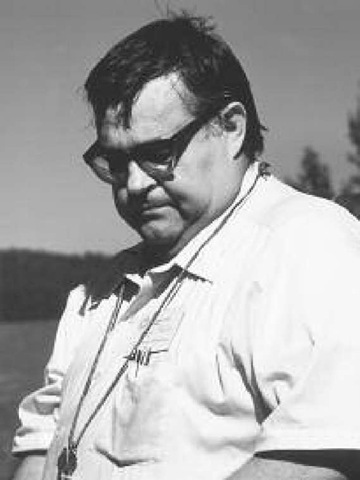(1932- ) American Isotope Geochemist
In addition to the more commonly known radioactive isotopes, there are also stable isotopes, which do not decay. These isotopes act as tracers for geologic processes that involve fluids or melts. There are characteristic signatures of stable isotope ratios that depend upon the source of the fluid or melt. The reason for the variation in the ratios is because the different isotopes will tend to enrich or partition by different geologic processes. Hugh Taylor is likely the foremost expert on stable isotopes with special interest in oxygen, hydrogen, carbon, and silicon. He has analyzed stable isotopes on rocks and soils from all over the Earth and the Moon as well as meteorites. He analyzed the lunar rock and soil samples retrieved during the Apollo missions and produced the definitive works on stable isotopes on the Moon (for example, the paper, “Oxygen and Silicon Stable Isotope Ratios of the Luna 20 Soil”). He also did some groundbreaking work on stable isotopes in tektites (meteorites) and impact generated glass.
Hugh Taylor on a field trip in California
Taylor’s most notable research, however, is on terrestrial geology, which is much more varied because the systems are more complex. His research is primarily on plutonic rocks, both granitoid and layered mafic intrusions, but he has also done work on volcanic rocks and metamorphic rocks. The two geographic areas where he has concentrated his work on granitoid plutonic rocks are in western North America where he studies Meso-zoic and Cenozoic plutonism, and western Europe where he studies late Paleozoic Hercynian plutonism. This research involves the determination of the source of the magma that formed the plutons as well as the interaction of the fluids expelled during the crystallization of the magma with the country rock. Examples of publications include The Oxygen Isotope Geochemistry of Igneous Rocks and Stable Isotope Geochemistry. This aspect of his research has shed light on the processes of contact metamorphism around these plutons as well as the hydrothermal activity generated by de-watering plutons. This activity has produced significant deposits of ore minerals, an example of which is the Comstock Lode, Nevada, which Taylor studied. An example of this work is the paper “Hydrogen and Oxygen Isotope Ratios in Minerals from Porphyry Copper Deposits.”
His interest in ultramafic rocks and layered mafic intrusions has taken Taylor all over the world. He studied layered intrusions from Africa (Skaergaard) to Alaska and ophiolites from Oman (Samail) to Cyprus (Troodos) to California, in addition to mantle fragments (xenoliths), komatiites from Australia and ocean fragments. This research has focused on both the alteration of these bodies after they were emplaced, and also their origins. The mantle processes involved in their generation is further elucidated in studies of volcanic rocks. An example of this work is the paper “Stable Isotope Studies of Ultramafic Rocks and Meteorites.” He studied potassic volcanic rocks from all over the world including Australia, East Africa, Antarctica, Italy, and the central United States. This work led Taylor to propose that there are even fluid-rock interactions in the upper mantle. Taylor has shown through stable isotopes that this interaction of fluids and solid rock, with or without melt as a chemical system, explains many of the features and processes we see in plutons, volcanoes and ore deposits.
Hugh Taylor was born on December 27, 1932, in Holbrook, Arizona. He attended the California Institute of Technology in Pasadena, where he earned a bachelor of science degree in geochemistry in 1954. He entered Harvard University, Massachusetts, for graduate studies and earned a master of arts degree in geology in 1955. Upon graduation he accepted a position as chief scientist aboard a cruise vessel for the U.S. Steel Corporation, where he explored for iron ore in southeast Alaska in 1955 and 1956. He returned to graduate school at California Institute of Technology and earned a Ph.D. in geochemistry in 1959. Taylor was also married that year. He then joined the faculty at California Institute of Technology, where he remains today. He was a member of the faculty at the Pennsylvania State University at University Park in 1961-1962, a visiting professor at Stanford University, California, in 1981-1982, a Crosby Visiting Professor at Massachusetts Institute of Technology and a geologist for the U.S. Geological Survey in Saudi Arabia in 1980-1981. Taylor was named Robert P. Sharp Professor of geology in 1981, a title which he still holds. He was also the executive officer for geology at Cal Tech from 1987 to 1995.
Hugh Taylor has led an extremely productive career. He is an author of 159 articles in international journals and professional volumes. Many of these papers are the often-cited definitive studies on stable isotopes and appear in the top journals in the profession. Taylor has received several honors and awards for his contributions to the science. He is a member of the National Academy of Sciences and a Fellow of the American Academy of Arts and Sciences. He was awarded the Urey Medal by the European Association of Geochemistry and the Arthur C. Day Medal by the Geological Society of America. He received a Best Paper Award from the U.S. Geological Survey. He has been named to several prestigious endowed lectureships including a Cloos Memorial Scholar at the Johns Hopkins University, a Turner Lecturer at University of Michigan, the First Hoffman Lecturer at Harvard University, the 30th William Smith Lecturer for the Geological Society of London, and an Invited Lecturer at the Italian Academy of Sciences.
Taylor has also performed service to the geological profession. He has served on numerous committees and panels and even held offices for the Geological Society of America, the Geochemical Society, and the Mineralogical Society of America. He has also served in editorial positions, including editor for Chemical Geology and associate editor for Geochimica et Cosmochimica Acta and Geological Society of America Bulletin.

